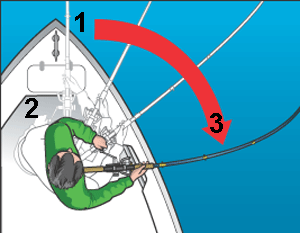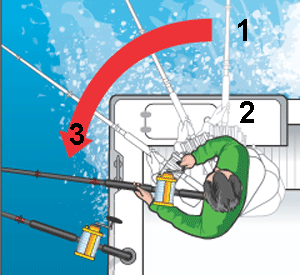Some anglers spend a small fortune'’’and in some cases a large one'’’on the best boat, electronics and tackle to catch that special trophy fish. Yet they blow the opportunity to score because they don't know how to set the hook effectively. To bolster your hook-up ratio, you must use a tactic that complements the fishing method, be it casting lures or baits, trolling or bottom fishing. Once you understand the mechanics and get the knack of setting a hook, very few fish will be able to shake their way free'’’and that includes the trophies.
 |
| CASTING CALL: [1] Point the horizontal rod at the bait. [2] Reel tight to the fish. [3] Swing the rod 90 degrees to set the hook. Illustration: Pete Sucheski |
This stroking move provides maximum leverage, compared to rearing back on the rod vertically, high over my head.
If the hook should miss the fish, the bait will remain in the water close to the predator, where it may draw another strike. If I had whipped the rod vertically over my head, I would have risked launching the bait into the air'’’and out of the strike zone. Of course, I sometimes hold the rod vertically, such as when I'm working a topwater plug or swimming a live bait at the surface. But, on the strike, I'll wind tight to the fish and switch over to the horizontal hookset. To execute the strike properly, keep the rod parallel to the water and wind tight until the fish stops the spool and begins to take line. At this point, slightly cup or thumb the reel spool to generate additional drag for a split second or two, and rear back on the rod to one side. Winding tight to the fish and adding extra drag pressure lets me eliminate most of the line stretch, practically guaranteeing a solid hookset (see �’Learn About Line Stretch,�’’ on page 36). But don't add too much drag, which could break the line. Get a feel for the process, which means knowing when you're close to breaking the line, or if the fish is wallowing in place or about to make a powerful run.
 |
| TROLL GOAL: [1] Point the rod at the bait. [2] Let the fish take line. [3] Hold the rod at a 45-degree angle on the hookset. Illustration: Pete Sucheski |
When I am trolling'’’whether I am offshore targeting wahoo, tuna, dolphin and billfish or seeking kings, grouper or snook inshore'’’and I get a strike, I keep the boat at the same heading and trolling speed for 30 seconds. The boat's momentum helps take the stretch out of the line. Once the hook is firmly set, I'll slow the boat for the fight. Maintaining the trolling speed and direction keeps the other baits in play, and that's when I'll often double or triple up on schooling fish. Should the rod arch over on the strike and line begin racing from the reel, I'll pick up the outfit and impart a series of short and quick sweeps of the rod. In this case, I hold the rod at a 45-degree angle to the water. This angle yields more leverage and will keep the bait in the action if the fish drops it. When dropping back to a billfish or dolphin, I'll immediately point the rod at the bait and free spool. Once I feel the fish take the bait, I'll engage the drag and quickly wind the line tight. When the fish races off, I set the hook. They often don't act as though they have felt the point of the hook, instead swimming off slowly and taking line or wallowing in place. When this occurs, I'll wind tight to the fish and increase drag pressure by either pressing the line between my thumb and the rod's foregrip, or slightly advancing the lever drag if I'm using a conventional reel. But I try to remember to immediately back off this additional drag once I sense the fish is about to take off.
 |
| PULLING FOR YOU: [1] Hold the rod steady. [2] Wind tight, and let the fish pull the rod down. [3] Lift the rod and set the hook. Illustration: Pete Sucheski |
Learn About Line Stretch
Take this factor into account before tussling with trophy fish.
When setting the hook, consider the type of line on the reel. Nylon monofilament, the most widely used fishing line, both inshore and offshore, has inherent stretch'’’up to 25 percent of its length. For example, it's quite possible that 100 feet of the stretchiest mono will stretch as much as 25 feet. This elasticity makes mono more forgiving than today's stretch-free super braid'’’not always bad because mono can absorb the sudden stress of surging fish, keep the line from parting or prevent the hook from ripping free. But line stretch can make setting a hook difficult. The greater the distance between you and the fish, the more line stretch you'll have to overcome to plant a hook firmly.
'’’ G.P.

